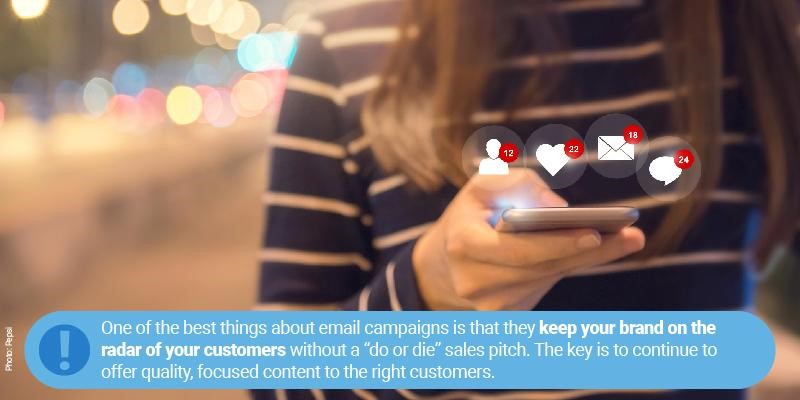Email campaigns are one of the most effective forms of marketing today. A recent study estimates that for every dollar spent, return on investment (ROI) is approximately $38! Obviously, all email campaigns do not yield such results. There are several factors which can add up to making an email marketing campaign more or less successful. It is important to keep in mind that individuals receive more emails now than ever. Getting the right content in front of the right eyes is paramount.
Effective Email Campaigns Reach the Right Audience

The best marketing material in the world will not be effective if it does not reach the correct audience.[1] When it comes to email campaigns, that means creating and building your ideal email list.
Creating an email list can be achieved in a number of ways. Most business websites direct customers to sign up for emails, have a “contact us” page to collect email addresses, or both. Brick and mortar stores can also use a manual registration sheet at the cashier. Finally, some email lists are available for sale. Most, but not all, “for sale” email lists are untargeted and ineffective.
Expanding an email list primarily occurs through incentivizing your existing customers to share your social media or email materials. Many brands use social media contests or “invite a friend” email offers. Whether you are just getting started or wanting to build upon an existing email list, the key is to convert clicks to subscriptions.
Sending a Clear Message Through Email

With that in mind, it is important to understand that all email list subscribers are not created equal. Some email campaigns choose to highly incentivize signing up without clearly communicating the nature of the product, service, or even the subscription. This may result in a larger, but less engaged email list.
Consider instead that every social media post and/or email is an opportunity to introduce your brand to a prospective customer.[2] The content of each email should be clear and enticing to drive subscriptions for your desired clientele.
Another consideration when it comes to sending a clear message is insider information. We understand that industry professionals know their businesses inside and out. This can lead some marketing materials to be too demanding on consumers. Effective email marketing gives the necessary information in such a way that anyone can understand the material.
Utilizing Automation for Email Marketing Campaigns
Automated emails are extremely common in today’s market. We are all used to receiving an email confirming our purchase, confirming we have changed our password, and that our food delivery is on the way. But automated emails can be so much more than simple action-reaction. Examples of automated emails to keep customers engaged include:
- Confirmation emails – still the king of automated emails, the modern consumer expects to receive a quick note confirming that recent purchase, cancelation, or other action.
- Welcome emails – a “thank you” or welcome email upon subscribing is another industry standard which brings your customer into the fold.
- Reminder emails – has your customer had a product on hold for a week? Have they been inactive for a month? Rules in your email strategy can allow you to keep in touch with customers without inundating them with unnecessary information.
- Relevant sales and/or news – this type of email can be driven by a number of factors, including past purchases, website visits, or clicks on previous emails.
- Customer satisfaction emails – sending a customer satisfaction email is a gentle way of letting your customer know that you care about their experience without trying to make a sale.
- Much more – there are dozens of ways that an automated email campaign can grow your business.
Turning Email Marketing into Sales

A robust and engaged email list is great, but that doesn’t mean much if those readers aren’t turning into customers. One of the best things about email campaigns is that they keep your brand on the radar of your customers without a “do or die” sales pitch. The key is to continue to offer quality, focused content to the right customers.[3]
As we have discussed, finding the right customers, sending the right material, and automating emails are three of the pillars of a successful email marketing campaign. Once that pipeline has been established, it is time to track the data and fine tune your formula.
Reviewing conversion rates, open rates (the percentage of recipients who read
the email), and so on will give you a clear picture of what is and what is not
working. Your marketing team can then adjust your strategy to turn those clicks
into paying customers.
Get the Most from your Email Campaign with Clock Tower Insight
At Clock Tower Insight, we turn data into business solutions. By maximizing brand positioning, CX management, moments of influence, and more, we help build our clients’ brands in the short and long term. Clock Tower Insight believes that happy customers equal a happy business. We work closely with clients to tailor their brand from top to bottom in order to maximize positive image, exposure, and sales.
To learn more about how we may be able to help your business grow, read about our 15 plus years of focused experience working with brands such as Starbucks, Kraft, McDonald’s, and much more.

